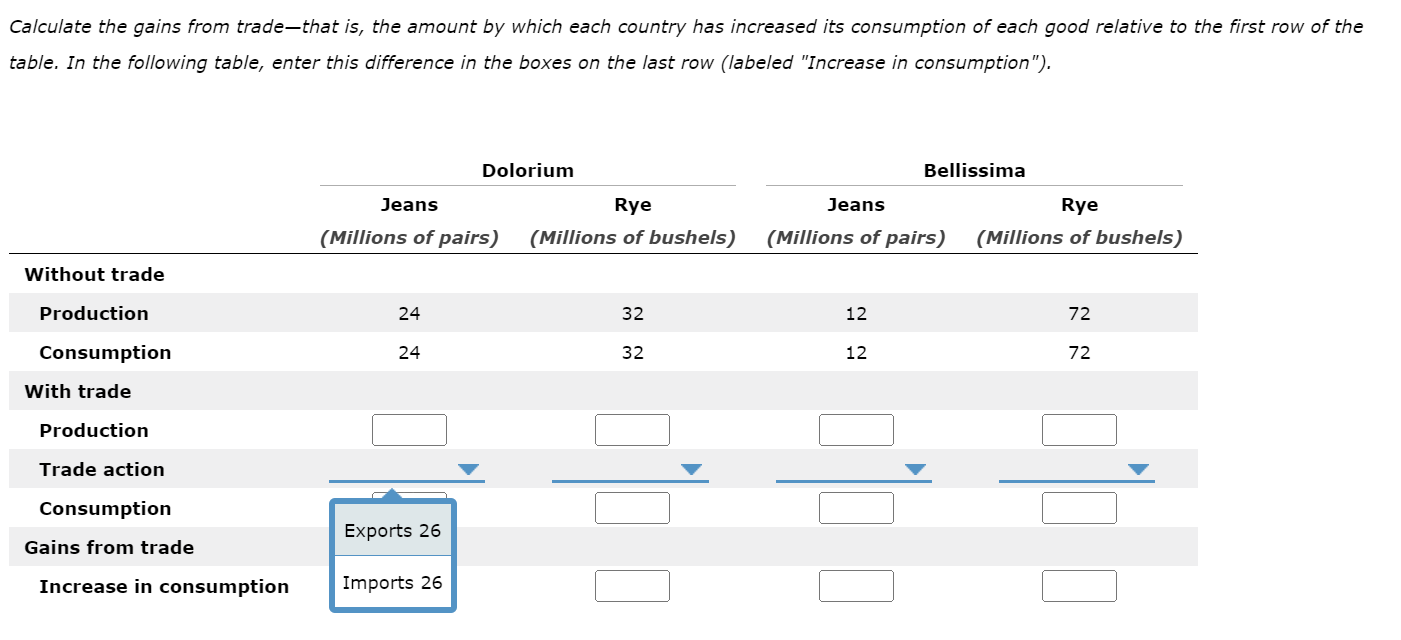Question
Consider two neighboring island countries called Dolorium and Bellissima. They each have 4 million labor hours available per month that they can use to produce
Consider two neighboring island countries called Dolorium and Bellissima. They each have 4 million labor hours available per month that they can use to produce jeans, rye, or a combination of both. The following table shows the amount of jeans or rye that can be produced using 1 hour of labor.

Initially, suppose Bellissima uses 1 million hours of labor per month to produce jeans and 3 million hours per month to produce rye while Dolorium uses 3 million hours of labor per month to produce jeans and 1 million hours per month to produce rye. Consequently, Dolorium produces 24 million pairs of jeans and 32 million bushels of rye, and Bellissima produces 12 million pairs of jeans and 72 million bushels of rye. Assume there are no other countries willing to trade goods, so, in the absence of trade between these two countries, each country consumes the amount of jeans and rye it produces.
Fill in the Blanks
Doloriums opportunity cost of producing 1 pair of jeans is (1/2, 1/4, 2, or 4 bushels) of rye, and Bellissimas opportunity cost of producing 1 pair of jeans is (1/2, 1/4, 2, or 4 bushels) of rye. Therefore, (Bellissima/Dolorium) has a comparative advantage in the production of jeans, and (Bellissima/Dolorium) has a comparative advantage in the production of rye.
Suppose that each country decides to completely specialize in the production of the good in which it has a comparative advantage, producing only that good. In this case, the country that produces jeans will produce ____ million pairs per month, and the country that produces rye will produce ____ million bushels per month.
Now, suppose the country that produces jeans trades 26 million pairs of jeans to the other country in exchange for 78 million bushels of rye.
In the following table, use the dropdown menus to select the amount of each good that each country exports and imports on the row labeled "Trade action." Then enter each countrys final consumption of each good in the boxes on the row labeled "Consumption."
When the two countries did not specialize, the total production of jeans was 36 million pairs per month, and the total production of rye was 104 million bushels per month. Because of specialization, the total production of jeans has increased by ____ million pairs per month, and the total production of rye has increased by ____ million bushels per month.
 Dolorium Consumption in RYE (imports OR exports 78)
Dolorium Consumption in RYE (imports OR exports 78)
Bellissium Consumption in JEANS (imports OR exports 26)
Bellissium Consumption in RYE (imports OR exports 78)
Jeans Rye \begin{tabular}{lcc} Country & (Pairs per hour of labor) & (Bushels per hour of labor) \\ \hline Dolorium & 8 & 32 \\ Bellissima & 12 & 24 \end{tabular} Calculate the gains from trade-that is, the amount by which each country has increased its consumption of each good relative to the first row of the table. In the following table, enter this difference in the boxes on the last row (labeled "Increase in consumption")Step by Step Solution
There are 3 Steps involved in it
Step: 1

Get Instant Access to Expert-Tailored Solutions
See step-by-step solutions with expert insights and AI powered tools for academic success
Step: 2

Step: 3

Ace Your Homework with AI
Get the answers you need in no time with our AI-driven, step-by-step assistance
Get Started


